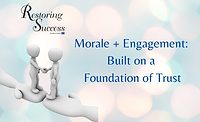Restoring Success: Building a Solid Foundation for Success with Program Work

“Anything worth doing, is worth doing right.” ― Hunter S. Thompson
Programs, TPAs, Third Party Administrators, there are a variety of terms to describe the presence of insurance programs in today’s restoration industry landscape. The scope and context of the relationships between TPAs, insurance companies, and restoration companies can vary by insurance carrier, and TPA.
It is important to understand how and why TPAs are part of our industry. Understanding will help you make decisions and develop your organization in the pursuit of excellence as you define it.
When you become a service provider/vendor on a program, you agree to a set of parameters and procedures. Also, you will be asked to present information about your company to qualify you to the standards that have been set forth. As an organization, it is a choice to render services based on the parameters outlined in the agreement that is executed between you and the program.
If you are doing it, and agreed to it, why not do it well?
The Basics: TPAs, Property Insurance Policies, & Premiums
TPAs are organizations with stakeholders, purpose, and a mission to serve not unlike any other organization or restoration company. Although there are a variety of offerings and agreements with insurance carriers, in general terms, they are providing a service to an insurance carrier. Their service is to assist and/or facilitate the claims processing needs of the carrier.
An insurance carrier is also an organization with stakeholders, purpose, and a mission. Their product is an insurance policy, a contract. Within the policy, there is a “promise to pay” the policyholder based on the verbiage in the policy. In a typical property policy, the promise to pay is based on the principle of indemnification, to make whole, in accordance with the policy terms. The policy is purchased by the policy holder, the insured, typically the property owner, for premium dollars.
The premium dollars are collected and pooled to manage the risk of damage to the properties. Dollars are paid out in accordance to the policy when a loss occurs, the claims process. The TPA offers services that can help contain the costs while still providing quality services. In short, there is a value proposition by the TPA to the insurance carrier.
The Claims Arm (Department) of the Property Insurance Carrier
The following is a very broad overview of key components:
- Claims Handling
- Cause of Loss
- Extent of Damage
- Final Disposition: Application of Coverage and Settlement/Payment
- Subrogation Potential
- Customer (Insured) Service and Experience
- Underwriting/Risk Management Service
A TPA offers services to the carrier’s claim department that are in alignment with their objectives and speak to minimizing the related expenses, and losses, while managing the insured’s (customer) experience.
The TPA delivers this service with a combination of resources that include but is not limited to software, employees, procedures, partners and/or vendors, i.e. restoration contractors. The program, the parameters, and the metrics in which the restoration company are operating with are designed to allow the TPA to deliver on the commitments that they made to the insurance carrier.
Achieve Excellence as a Program Partner/Vendor
-
Organizational understanding and buy-in: The company should be moving in the same direction. Ensure that there is a general understanding of:
- The big picture. As described above, understand where we fit as a restoration company and understand the objectives. Create a culture that is respectful to your relationship with the Program. Refer to the key responsibilities of the claims department and how they relate to your role.
- Go to the websites of the program(s) that you are on and review their commitments, mission statement, and value proposition.
-
Metrics/Scores/Grades: The metrics are designed to measure, monitor, and encourage performance to the objectives and the TPA’s commitment to the insurance carrier.
- Areas include but not limited to:
- The quality and timeliness of the delivery of services
- Customer service experience
- Accurate estimating
- Documentation and presentation of appropriate information
- Specific Metrics: Understand what each metric is measuring and how it is calculated. Once you gain this insight, you can link it to your individual organization’s movement and improve the metric.
- Monitoring: As an organization, have systems, accountabilities, and procedures in place to use the tools available to you to monitor and improve your results in-real time. Reports and/or dasher boards are readily available and should be used as a tool for your success.
- Areas include but not limited to:
- Ask for help: It is in the best interest of the TPA that you are working with for you to perform well. Know your point people and if you get stuck or have questions in the interest of improving your results, ask for help and ask the right questions.
-
Positive Attitude: Having a positive attitude about the program work that you are doing is of critical importance within your organization. If there are parts of program work that you do not like, change your focus to the positives.
- Opportunities to improve: If your performance based on the metrics presents areas in need of development, look at it as constructive feedback and a gift. You can zone in on areas to improve your operation. Once you understand the metric, consider it objectively and view it as a reasonable expectation of a good restoration company.
- Relationship Development: Consider all the opportunities you are afforded to serve in your community and work with carriers that you have not worked with in the past.
- Motivation: The programs that you are working with have the best intentions for your success. You are an extension of their commitments to the carriers. It is in the TPA’s best interest for you to do well and succeed; embrace them as a partner.
If you are doing program work or would like to become a service provider, do it well and pursue excellence.
Looking for a reprint of this article?
From high-res PDFs to custom plaques, order your copy today!






